 It’s been 10 years since Dickie Meaden and Skoda smashed the G/PS top speed record at the Bonneville Salt flats, we reminisce…
It’s been 10 years since Dickie Meaden and Skoda smashed the G/PS top speed record at the Bonneville Salt flats, we reminisce…
There was a time when Skodas were the butt of every comedian’s jokes. If you write for the Daily Mail that time is still with us, but for the rest of us Skoda has morphed from Eastern Block oddity into a credible and creative European carmaker. That said, it was still something of a surprise when Skoda UK’s PR manager, Pietro Panarisi, calls to explain his idea to mark the tenth anniversary of Skoda’s vRS performance brand: a one-off Octavia that he hopes will do 200mph (320km/h) at Bonneville Speed Week. Oh, and would I like to be the driver?
And so it begins. The car is built from a regular production car, stripped and rebuilt into a salt-spec vRS saloon by Skoda UK technicians Andy Orme and Ricky Elder. Revo Technik’s Nick Kasberger provides engine tuning know-how and countless other specialists pitch in with help and advice. Mechanically it’s close enough to standard to comply with Bonneville’s production car class known as G/PS. The 2.0-litre TSI engine retains standard block, pistons, valves, cams, crankshaft, head gasket, coil packs and ECU. Factory conrods are replaced by items from Integrated Engineering and the turbo is a monster Garrett GT3562R. The intake, exhaust and cooling systems are also modified and the vRS transmission is swapped for the longer-striding ’box from an Octavia Greenline, Skoda’s economy-biased diesel.
Chassis-wise, the car sits 80mm lower than standard on adjustable dampers, while the regular wheels and tyres are replaced by skinny spacesaver-style rims fitted with bespoke Goodyear Eagle Bonneville tyres. You don’t brake on the salt, so the front discs are removed, but the Simpson parachute mounted on the rear of the car should be more than sufficient to slow the Skoda from what we hope will be the far side of 320km/h.
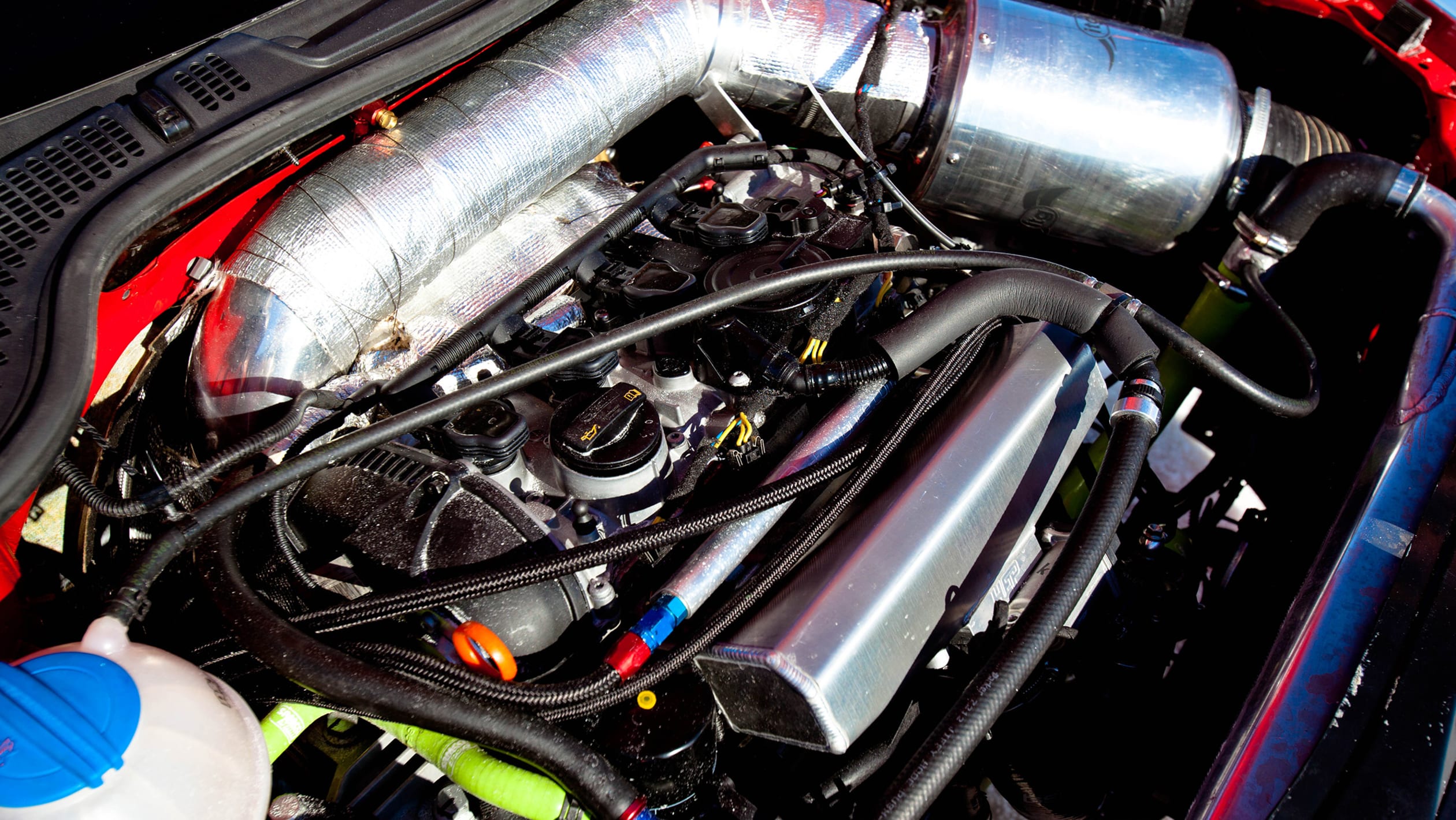 After spending six weeks in a container on a trans-Atlantic voyage, the Bonneville Octavia passes through customs at Long Beach before being hauled to Salt Lake City, where it’s subject to some final fettling and a crucial dyno session to get the engine working in Utah’s thin mountain air. It’s here I meet with the team and see the car for the first time since our shakedown at Bruntingthorpe. It’s the start of what we all hope will be an unforgettable adventure.
After spending six weeks in a container on a trans-Atlantic voyage, the Bonneville Octavia passes through customs at Long Beach before being hauled to Salt Lake City, where it’s subject to some final fettling and a crucial dyno session to get the engine working in Utah’s thin mountain air. It’s here I meet with the team and see the car for the first time since our shakedown at Bruntingthorpe. It’s the start of what we all hope will be an unforgettable adventure.
Speed Week begins with Tech Inspection, where the car undergoes detailed safety and eligibility checks. Some of the requirements seem arcane compared with European standards, but it’s one of the unspoken truths about Speed Week that the SCTA officials and emergency crews have seen drivers maim and kill themselves in a hundred different ways over the years. There might not be anything to hit out on the salt, but when things go gnarly, cars can tumble for hundreds and sometimes thousands of metres. Such catastrophic incidents are mercifully rare, but the SCTA learns from them. It’s this process that has shaped the specialised rules, regulations and cars that run here.
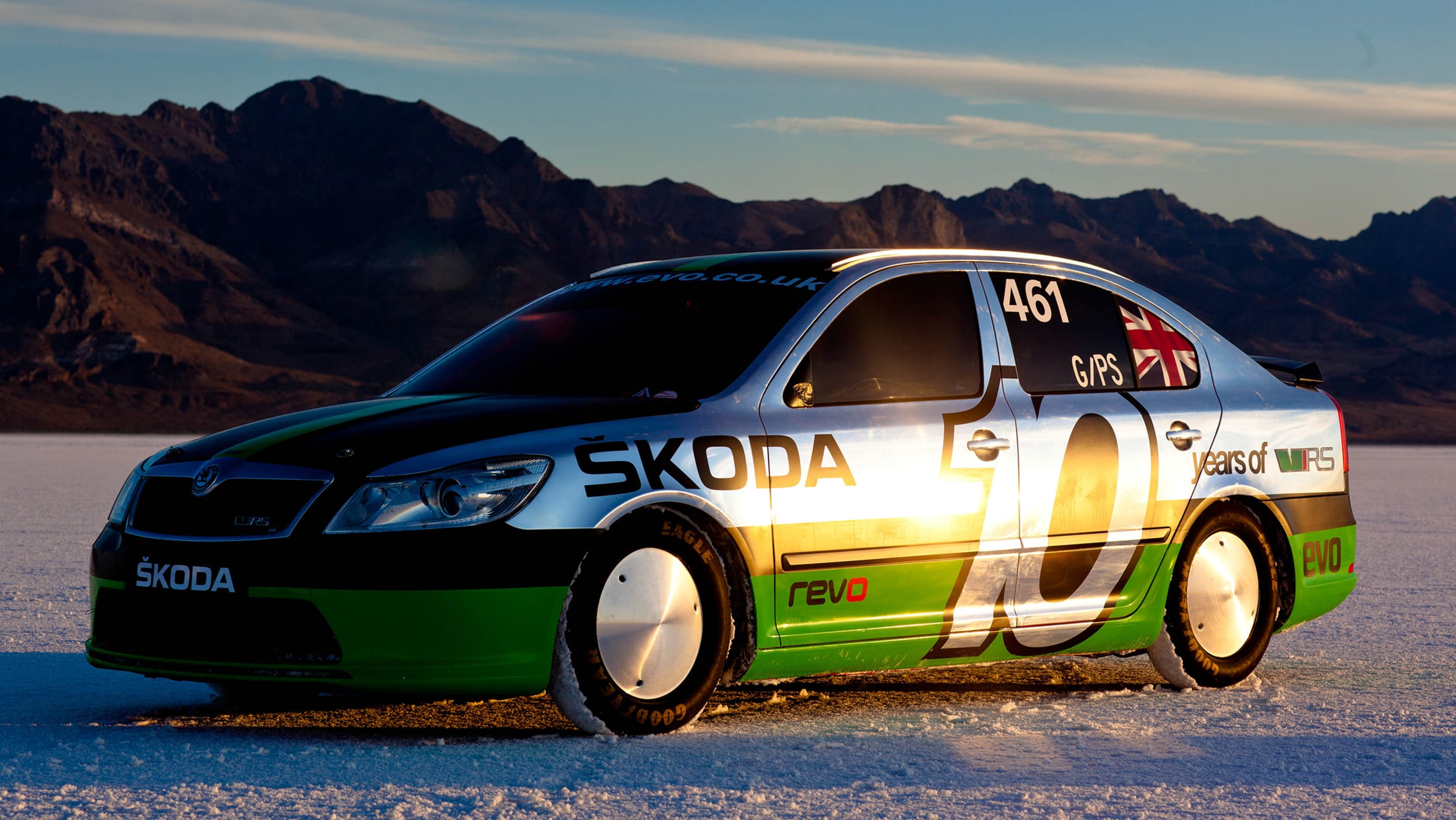 ‘Bale-out’ is one of the more sobering parts of Tech Inspection, for it’s where a driver has to prove he or she can pull the parachute, hit the extinguishers and operate the master switch, ignition and fuel pump switches then extricate themselves from the car in double-quick time. Sounds simple, but when you’re strapped into your seat so tightly you can barely breathe, have your helmeted and HANS-restrained head literally wedged between the wings of the metal seat’s head support, have your arms tethered by straps and are fully togged-up in a Top Fuel-dragster-spec firesuit and gloves, it’s anything but easy. I manage to drag myself out with the requisite urgency, but still I’m left with a lingering tinge of anxiety fizzing in the pit of my stomach. It might ‘only’ be driving fast in a straight line, but Speed Week is clearly a serious and dangerous business.
‘Bale-out’ is one of the more sobering parts of Tech Inspection, for it’s where a driver has to prove he or she can pull the parachute, hit the extinguishers and operate the master switch, ignition and fuel pump switches then extricate themselves from the car in double-quick time. Sounds simple, but when you’re strapped into your seat so tightly you can barely breathe, have your helmeted and HANS-restrained head literally wedged between the wings of the metal seat’s head support, have your arms tethered by straps and are fully togged-up in a Top Fuel-dragster-spec firesuit and gloves, it’s anything but easy. I manage to drag myself out with the requisite urgency, but still I’m left with a lingering tinge of anxiety fizzing in the pit of my stomach. It might ‘only’ be driving fast in a straight line, but Speed Week is clearly a serious and dangerous business.
There’s a record entry of just under 600 cars and motorcycles for that year’s Speed Week. Judging by the wide-eyed faces gathered around for the drivers’ briefing, that means a record number of salt virgins. If they’re anything like me, they’ll be experiencing a weird blend of apprehension, excitement and belonging. It might be new and bewildering, but if you’ve got the slightest drop of petrol in your veins, standing on the salt beneath Utah’s baking sun feels as right as anything can in life.
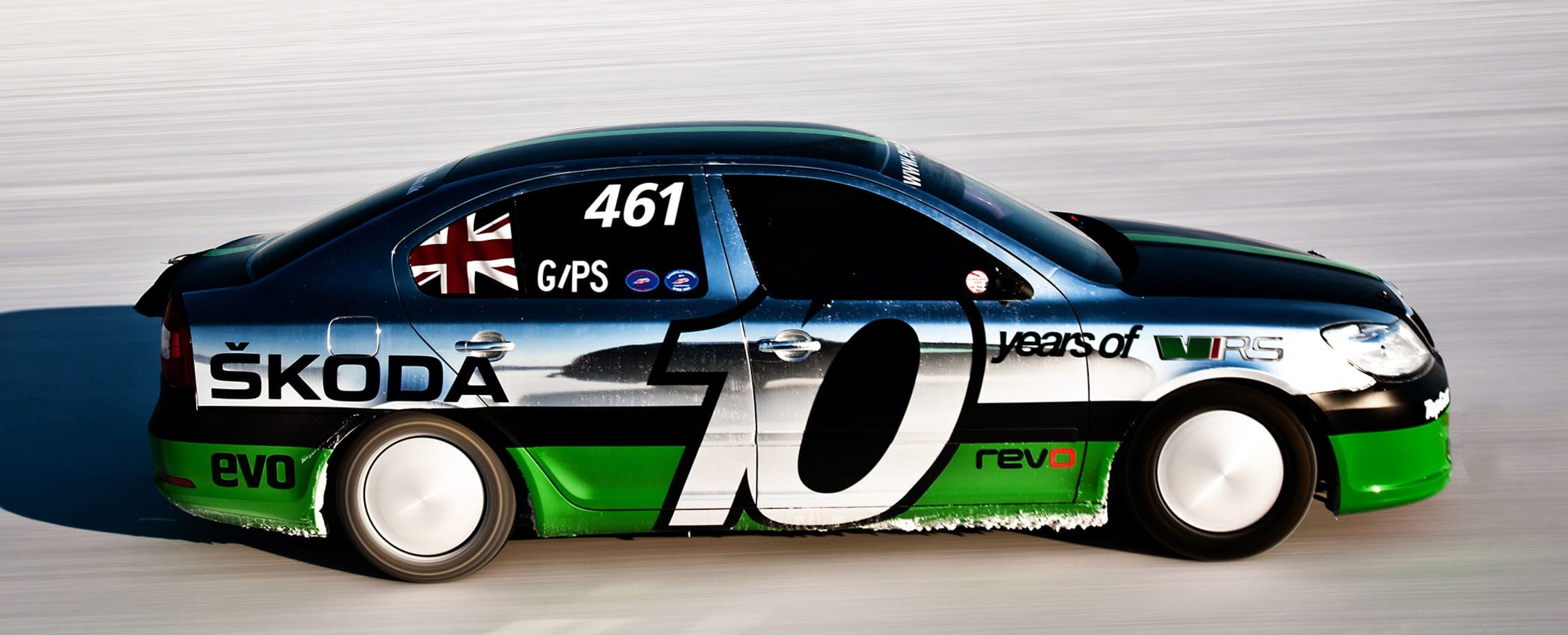 The white stuff is a weird surface on which to drive. First thing in the morning it’s sticky underfoot and cakes to car tyres and the soles of your shoes. As the sun begins to climb and the ambient temperature rises, the salt dries and hardens, but still it proffers very little grip. Imagine accelerating on something part-way between damp sand and freshly fallen snow and you get the idea. Because of its unique properties, all new drivers have to complete a mandatory rookie run on Course 4, the shortest on the salt at just three miles. There’s no minimum speed limit, but you’re strictly forbidden to exceed 150mph, as the objective is to prove you can operate your car safely and follow instructions, not break records. However, if you can average anywhere between 125mph (200km/h) and 150mph (240km/h) you qualify for a D licence test as well as shedding rookie status.
The white stuff is a weird surface on which to drive. First thing in the morning it’s sticky underfoot and cakes to car tyres and the soles of your shoes. As the sun begins to climb and the ambient temperature rises, the salt dries and hardens, but still it proffers very little grip. Imagine accelerating on something part-way between damp sand and freshly fallen snow and you get the idea. Because of its unique properties, all new drivers have to complete a mandatory rookie run on Course 4, the shortest on the salt at just three miles. There’s no minimum speed limit, but you’re strictly forbidden to exceed 150mph, as the objective is to prove you can operate your car safely and follow instructions, not break records. However, if you can average anywhere between 125mph (200km/h) and 150mph (240km/h) you qualify for a D licence test as well as shedding rookie status.
On the dyno at Salt Lake City, the Octavia managed 380kW at the wheels in 100 degree ambient temperatures and one mile above sea-level. That’s a lot to put through the front wheels of any car, let alone one running skinny tyres pumped to 60psi on a strangely slick surface. Everything’s fine until 5500rpm, at which point the turbo begins to wake up. A thousand rpm later it’s fully lit and so are the front wheels. It demands the shortest of short shifts through the first four gears, and even then it’ll break traction at will.
 We get the rookie run and D licence run done in one hit, leaving me to complete my C, B and – hopefully – A licence runs. This means working up my average speeds in 40km/h increments from 240km/h to 200mph (320km/h) and beyond. Each run is a brilliant confidence- booster for me and provides invaluable data for the guys. It’s also proving effortless for the Octavia and bodes extremely well for our double-ton objective.
We get the rookie run and D licence run done in one hit, leaving me to complete my C, B and – hopefully – A licence runs. This means working up my average speeds in 40km/h increments from 240km/h to 200mph (320km/h) and beyond. Each run is a brilliant confidence- booster for me and provides invaluable data for the guys. It’s also proving effortless for the Octavia and bodes extremely well for our double-ton objective.
We make our first 200mph attempt on Monday afternoon. It’s clear the car has huge untapped potential, but it’s also apparent the standard ECU and ignition coil packs are close to the limit of what they can cope with. It’s Nick’s job to coax more from the hardware by being creative with the software, but doing it on the hoof is a huge challenge. Despite the growing pressure, Nick, Ricky and Andy are all adamant that the car will do the job: if it can pull 7000rpm in fifth, the gearing and rolling radius of the tyres will dictate a speed of 202mph. Nick has warned me I’ll need to be sensitive to the fuelling issues and possibly have to back off the throttle ever-so slightly at high rpm to try and help the injectors and coil packs catch up with the demands for more fuel and a stronger spark. Sure enough, it falters slightly but clears with some coaxing and pulls strongly to the rev limit Nick set.
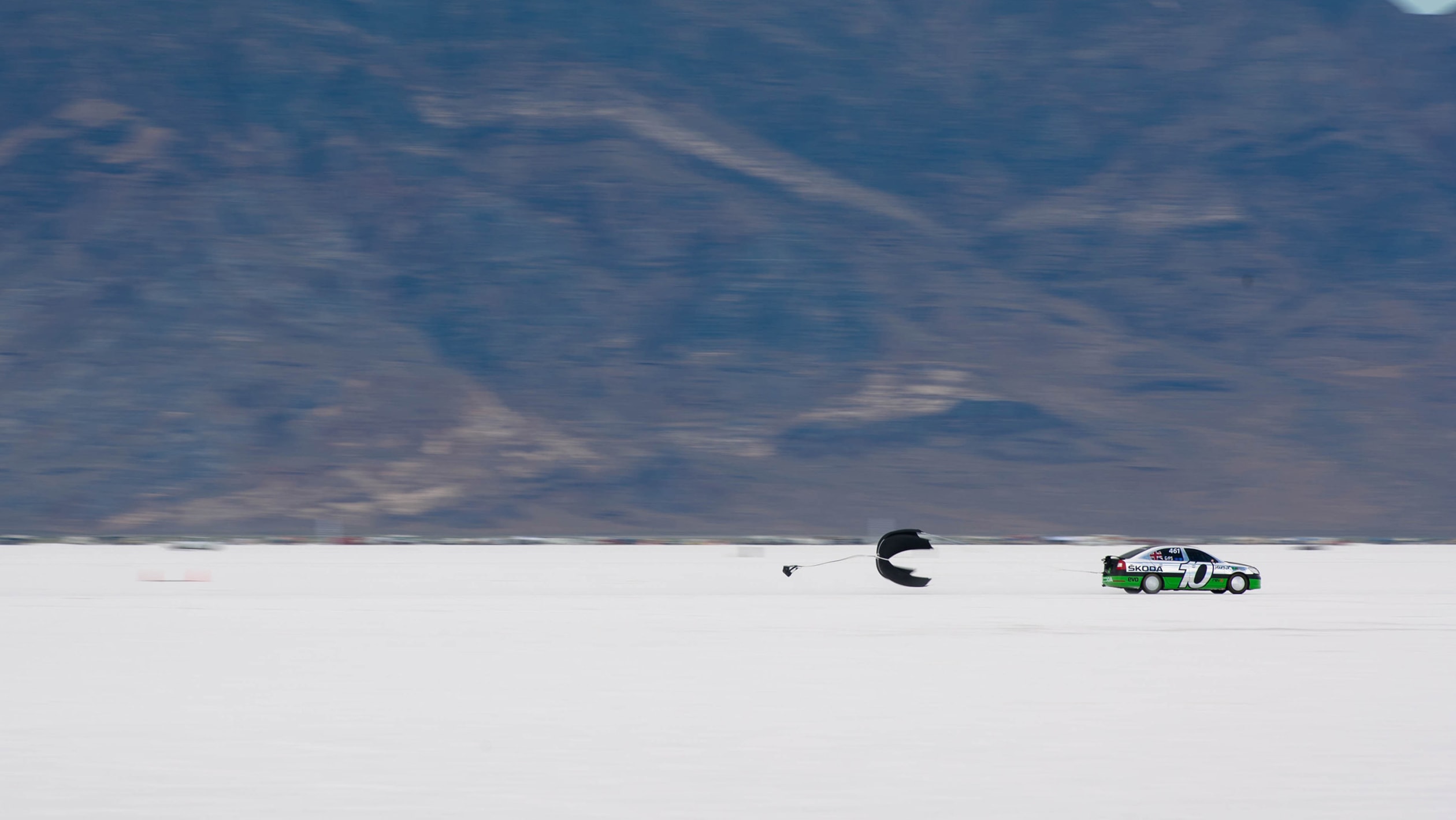 As the Octavia rolls to a halt, dragging its flaccid ’chute behind, I’m not certain what our speed was, but when I hear the boys hollering from the big white Dodge Ram pick-up storming up the course to meet me, I know we’ve topped 200. A timing slip confirms the good news: 202.15mph (325.33km/h). We’re all mildly stunned at the relative ease with which the Octavia has done it. The class record of 216mph (347km/h) is still a long way off, but with four days left and plenty to come from the motor, we know we have a good shot at doing something really special.
As the Octavia rolls to a halt, dragging its flaccid ’chute behind, I’m not certain what our speed was, but when I hear the boys hollering from the big white Dodge Ram pick-up storming up the course to meet me, I know we’ve topped 200. A timing slip confirms the good news: 202.15mph (325.33km/h). We’re all mildly stunned at the relative ease with which the Octavia has done it. The class record of 216mph (347km/h) is still a long way off, but with four days left and plenty to come from the motor, we know we have a good shot at doing something really special.
Even when you’re not driving (which is much of the time) Bonneville can still blow your mind, as I discover when I see a streamliner in full flight for the first time. A pencil-thin profile silhouetted against the gently curving horizon, these wheel-driven missiles skim through your peripheral vision like small black bullets across a dazzling sea of white and blue. Distance and physics dictate the scene and soundtrack stay bewilderingly out of sync, the low oscillating drone of a blown V8 hauling hard on a 400+mph (650km/h) gear totally at odds with the speed you’re witnessing. I swear there’s a collective pause as all eyes track the projectile’s progress, then as the ’chutes billow and the engine noise is snuffed like a candle we all breathe a sigh of relief, shake our heads in a mix of awe and admiration, then carry on with whatever we were doing. It’s a defining part of the Bonneville experience.
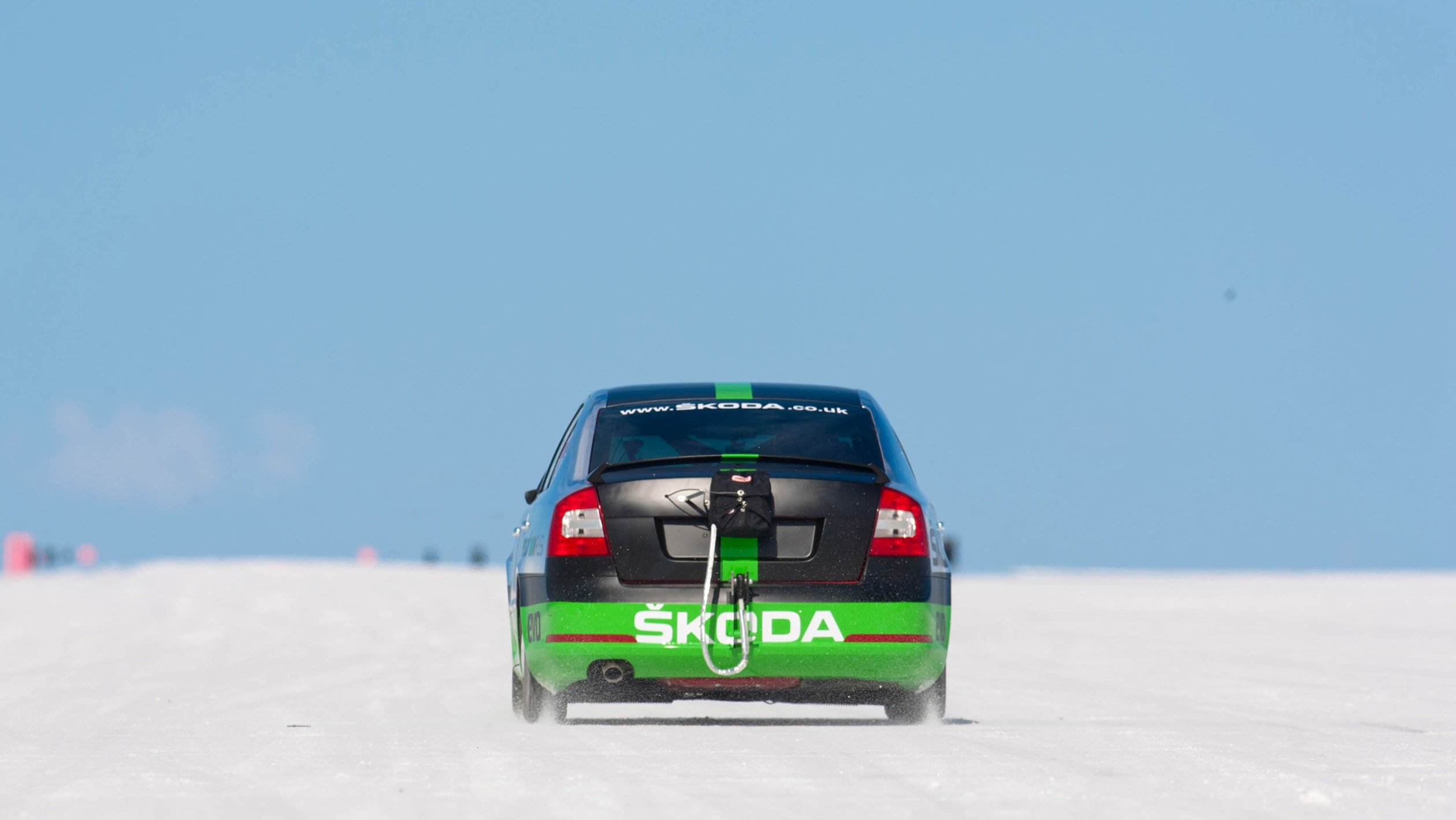 Things you take for granted when driving a standard car at high speed on a runway suddenly become magnified to an uncomfortable degree on the salt. Driving at 320km/h on a solid surface in a car designed to do 320km/h is no big deal, but contemplating 350km/h+ or more on slippery salt in a car with aerodynamics honed for 240km/h is more than a little spooky. You hope it won’t swap ends, take off or find some other catastrophic way of ruining your day, but hoping is very different to knowing, which explains why there’s a different vibe within the team when the time comes to go for the G/PS class record.
Things you take for granted when driving a standard car at high speed on a runway suddenly become magnified to an uncomfortable degree on the salt. Driving at 320km/h on a solid surface in a car designed to do 320km/h is no big deal, but contemplating 350km/h+ or more on slippery salt in a car with aerodynamics honed for 240km/h is more than a little spooky. You hope it won’t swap ends, take off or find some other catastrophic way of ruining your day, but hoping is very different to knowing, which explains why there’s a different vibe within the team when the time comes to go for the G/PS class record.
We have to make two runs above the existing record of 347km/h. The first run is in effect a qualification run that then entitles you to a record-setting attempt early the following day. It’s Thursday afternoon by the time our first chance comes. This means a further Tech Inspection to ensure the car is within the class rules. Fuel and water for the water-injection system is pumped out, then refilled with regulation fluids under the watchful gaze of SCTA officials. The tanks are then sealed and we’re waved towards the seven-mile-long Course 2. Having managed 344km/h earlier in the day, we’re confident the Octavia has speed to spare, but there’s only one way to find out.
 Nick has been constantly massaging the fuel mapping and we’re now beginning to get the car working well in sixth gear, but it’s not until I’ve soft-pedalled it through the first four gears, nailed it through fifth and dropped it into top at just over 320km/h that we know whether the latest tweaks have worked. There’s a momentary pause as the turbo winds itself up, but then the solid, relentless shove returns, powering the Octavia through the 350km/h barrier before hitting Nick’s chosen rev-limit at just under 363km/h!
Nick has been constantly massaging the fuel mapping and we’re now beginning to get the car working well in sixth gear, but it’s not until I’ve soft-pedalled it through the first four gears, nailed it through fifth and dropped it into top at just over 320km/h that we know whether the latest tweaks have worked. There’s a momentary pause as the turbo winds itself up, but then the solid, relentless shove returns, powering the Octavia through the 350km/h barrier before hitting Nick’s chosen rev-limit at just under 363km/h!
The shutdown procedure is always the same. Pop the ’chute while hard on the power to maintain stability, feel the drag pull the car back and down into the salt, then ease off the throttle and coast down in gear to ensure the maximum oil and coolant circulation. Only when we come to a halt is the motor finally switched off. As you can imagine, the heat-soak is always extraordinary, but on opening the bonnet I know something’s wrong. The engine is literally humming with heat. Smoke is curling from the heat-wrap and I can hear the water boiling inside the head and block. It looks, sounds and smells bad.
 After an agonising few minutes, the boys arrive and dump gallons of water over the engine to bring the temperatures down. They quickly establish it has blown a coolant hose during the run, though how early on we don’t know. It’s a desperate scene, for the 362km/h run will mean nothing if we can’t make a repeat run tomorrow. I return to Wendover feeling distraught and get a fitful night’s sleep.
After an agonising few minutes, the boys arrive and dump gallons of water over the engine to bring the temperatures down. They quickly establish it has blown a coolant hose during the run, though how early on we don’t know. It’s a desperate scene, for the 362km/h run will mean nothing if we can’t make a repeat run tomorrow. I return to Wendover feeling distraught and get a fitful night’s sleep.
Next morning the now familiar starting area has an added sense of purpose. The only cars here are those making record runs, so everyone is under the same stress as they line up to have their shot at history. The weather has taken a turn for the worse, with large thunderclouds encircling the Salt Flats and jagged forks of lightning sparking across the sky. It’s blustery too, with a powerful crosswind reportedly cutting a diagonal and potentially lethal path from left to right across both Long Courses.
There are a bunch of cars ahead of us in the queue for Course 2, but no one seems too keen on making a run. The start official makes his way down the line asking who’d like to go. A few drops of rain hit the Skoda’s windscreen as he reaches us. We all decide we haven’t come this far to be denied, so the boys wheel me up to the front of the line. This is it!
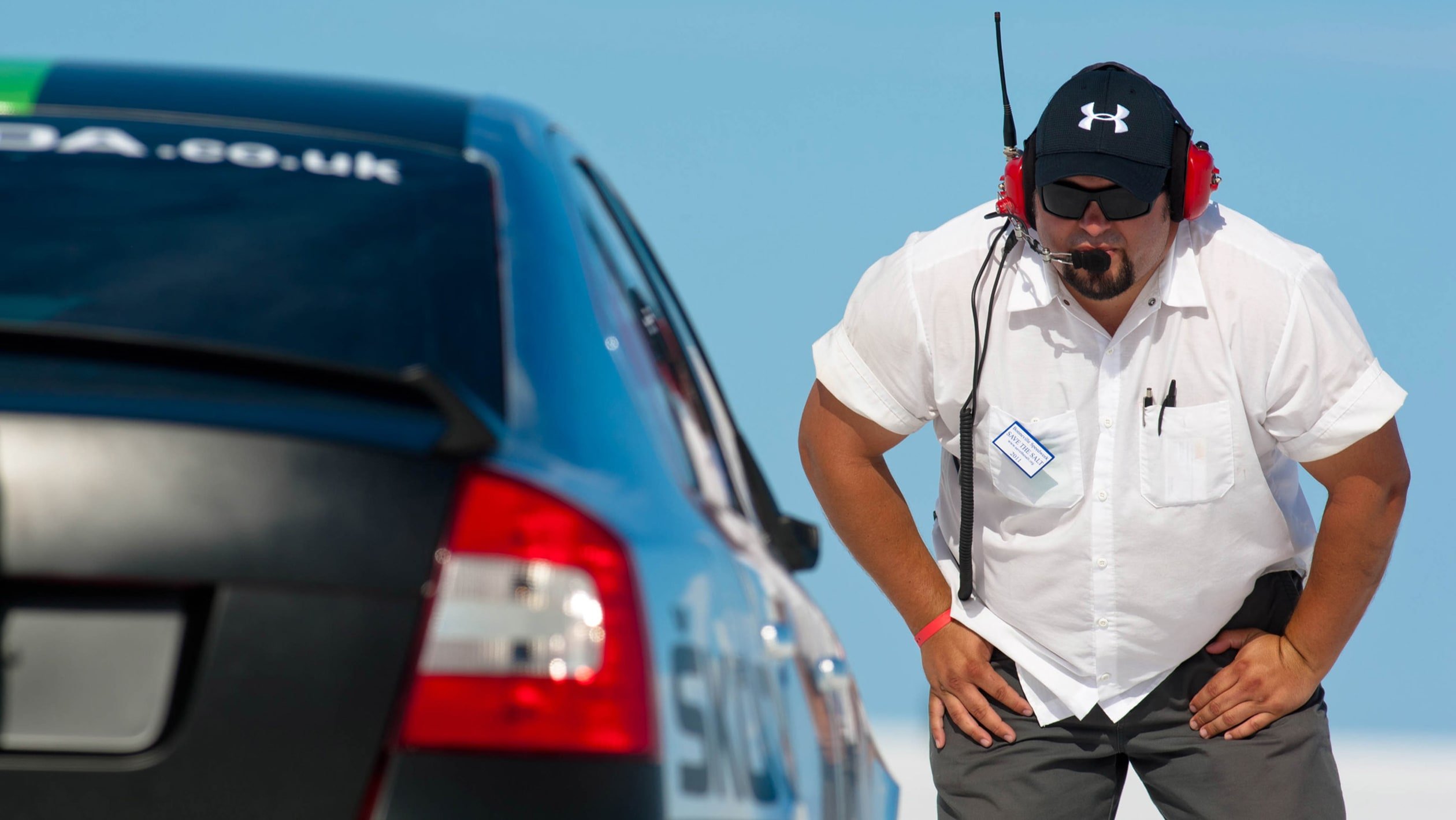 The start marshal always checks the driver is securely strapped in before they wave them off. Today is no different, except he’s also at pains to warn me of the crosswind (gusting to 25km/h somewhere between the 5.6 and 7.25km markers) and to remind me that I don’t have to make the run. Now in the grip of salt fever, I assure him I want to run, so he steps aside and waves me off.
The start marshal always checks the driver is securely strapped in before they wave them off. Today is no different, except he’s also at pains to warn me of the crosswind (gusting to 25km/h somewhere between the 5.6 and 7.25km markers) and to remind me that I don’t have to make the run. Now in the grip of salt fever, I assure him I want to run, so he steps aside and waves me off.
Revo Technik’s ‘Boss of Boost’ has wound a little more mumbo into the motor just to help us on our way. It’s hard to be sure, but it probably equates to almost 450kW at the wheels. The first four gears have always been traction-limited, but now as I shift up into 5th the Octavia’s clawing at the salt yet again, even as we pass 290km/h. Upshift to sixth at just over 320km/h and the revs drop straight back into the engine’s sweet spot. The super-long stride of top gear j-u-s-t tames the traction issues and the Octavia continues to accelerate with startling conviction, numbers piling on beyond 320km/h like never before, but just as I begin to relax into the run, the crosswind slams across the Octavia’s nose.
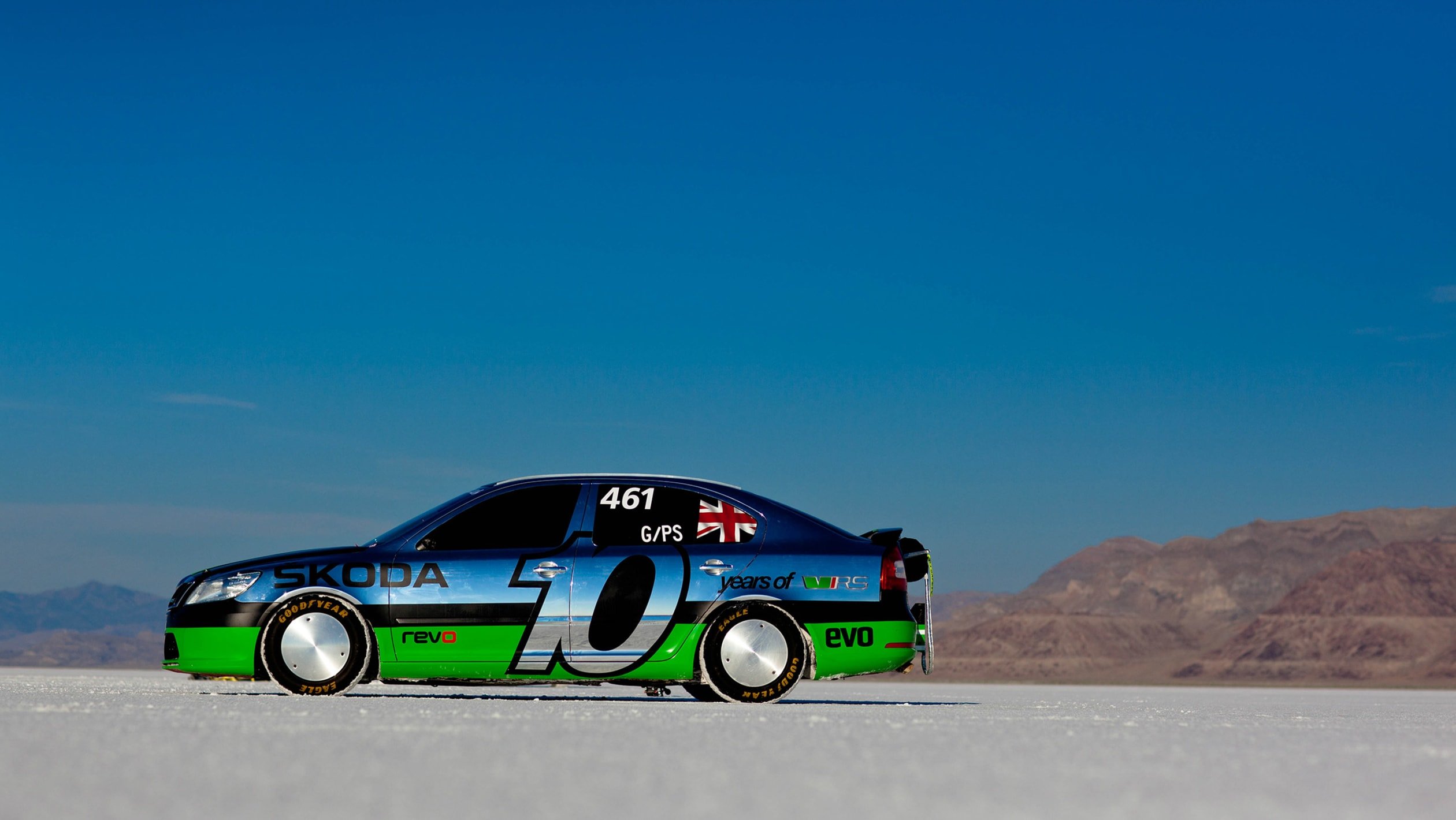 A more seasoned driver would have run up the left side of the 35-metre wide course, but nerves and inexperience mean I’ve driven straight up the middle. The crosswind is strong and sustained; shoving us a good 10 metres to the right before I’ve really had a chance to apply any left lock. In all previous runs – even a butt-puckering 325km/h test run with the rear boot spoiler removed – I’ve just nudged the Skoda’s steering with almost imperceptible inputs for fear of scrubbing speed, or worse upsetting its delicate directional stability. Now there’s nothing for it but to apply an eighth of a turn of left lock in the vain hope it’ll check our inexorable drift to the right.
A more seasoned driver would have run up the left side of the 35-metre wide course, but nerves and inexperience mean I’ve driven straight up the middle. The crosswind is strong and sustained; shoving us a good 10 metres to the right before I’ve really had a chance to apply any left lock. In all previous runs – even a butt-puckering 325km/h test run with the rear boot spoiler removed – I’ve just nudged the Skoda’s steering with almost imperceptible inputs for fear of scrubbing speed, or worse upsetting its delicate directional stability. Now there’s nothing for it but to apply an eighth of a turn of left lock in the vain hope it’ll check our inexorable drift to the right.
I fight the urge to lift even though for an uncomfortable few seconds I’m certain we’re going to leave the course. To my great relief we slip from the crosswind’s grasp with perhaps a metre to spare. From start to finish this heart-in-the-mouth moment has lasted no more than a handful of seconds, but at 366km/h that’s getting on for half a mile! I keep it pinned to the five-mile marker. On releasing the ’chute I’m instantly overwhelmed with relief, disbelief, pride, euphoria and a monster hit of adrenalin. We haven’t just beaten the record, we’ve smashed it, posting a peak average of 367.96km/h. When averaged with yesterday’s run, we get a new G/PS class record of 227.08mph (365.44km/h). It also means I become a life member of Bonneville’s 200mph (320km/h) Club and get a coveted red hat to prove it.
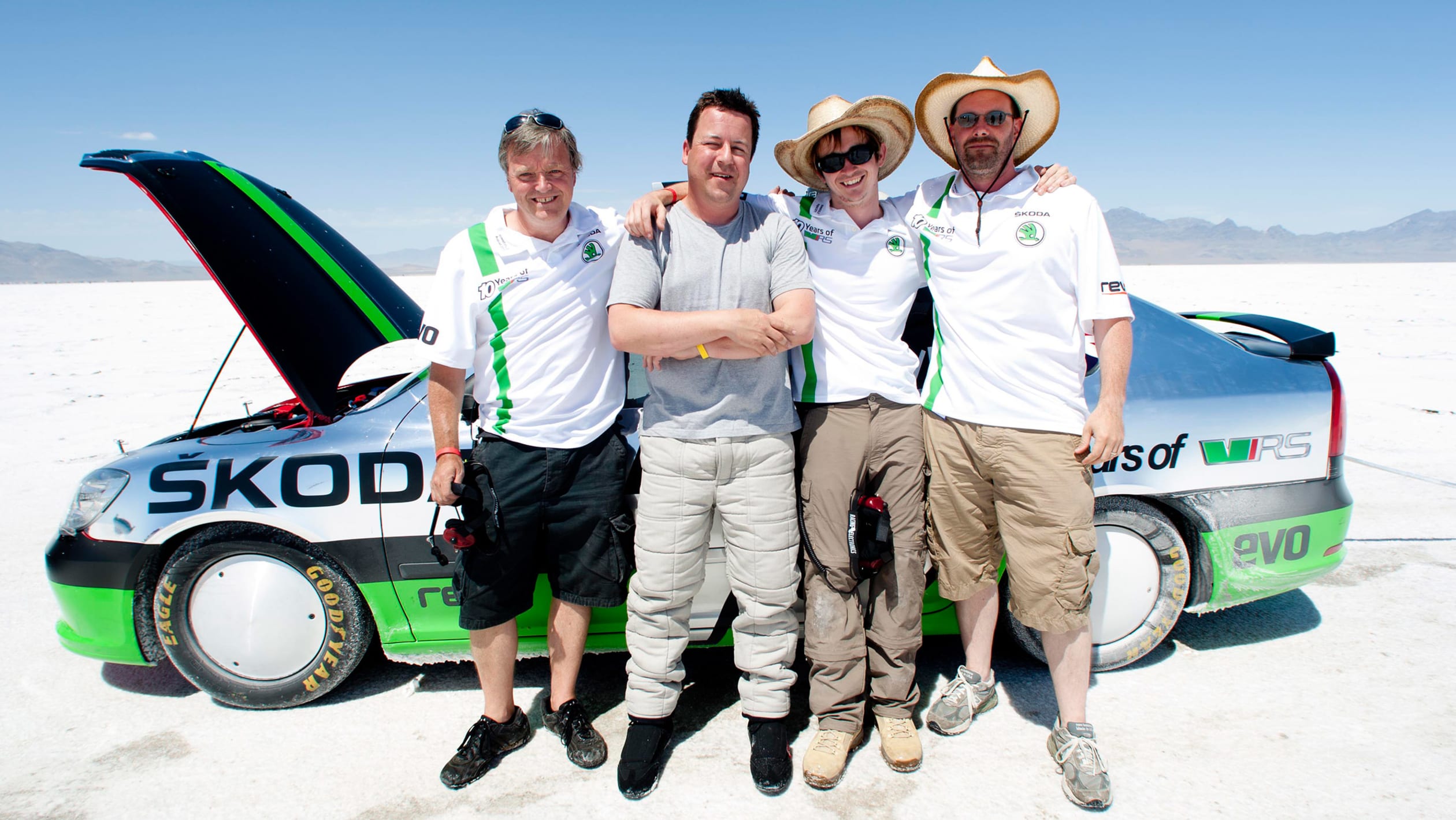 To come as rookies and leave as world record holders is testament to the imagination, skill and dedication of everyone involved. None of us will forget Speed Week. Moreover I suspect Speed Week won’t forget the curious Czech-born, British-built car that took a Land Speed Record and an unlikely place in history. To anyone who doubted the validity or relevance of this project, I’m pleased to say the joke’s on you. dedication of everyone involved. None of us will forget Speed Week. Moreover I suspect Speed Week won’t forget the curious Czech-born, British-built car that took a Land Speed Record and an unlikely place in history. To anyone who doubted the validity or relevance of this project I’m pleased to say the joke’s on you.
To come as rookies and leave as world record holders is testament to the imagination, skill and dedication of everyone involved. None of us will forget Speed Week. Moreover I suspect Speed Week won’t forget the curious Czech-born, British-built car that took a Land Speed Record and an unlikely place in history. To anyone who doubted the validity or relevance of this project, I’m pleased to say the joke’s on you. dedication of everyone involved. None of us will forget Speed Week. Moreover I suspect Speed Week won’t forget the curious Czech-born, British-built car that took a Land Speed Record and an unlikely place in history. To anyone who doubted the validity or relevance of this project I’m pleased to say the joke’s on you.
Richard Meaden




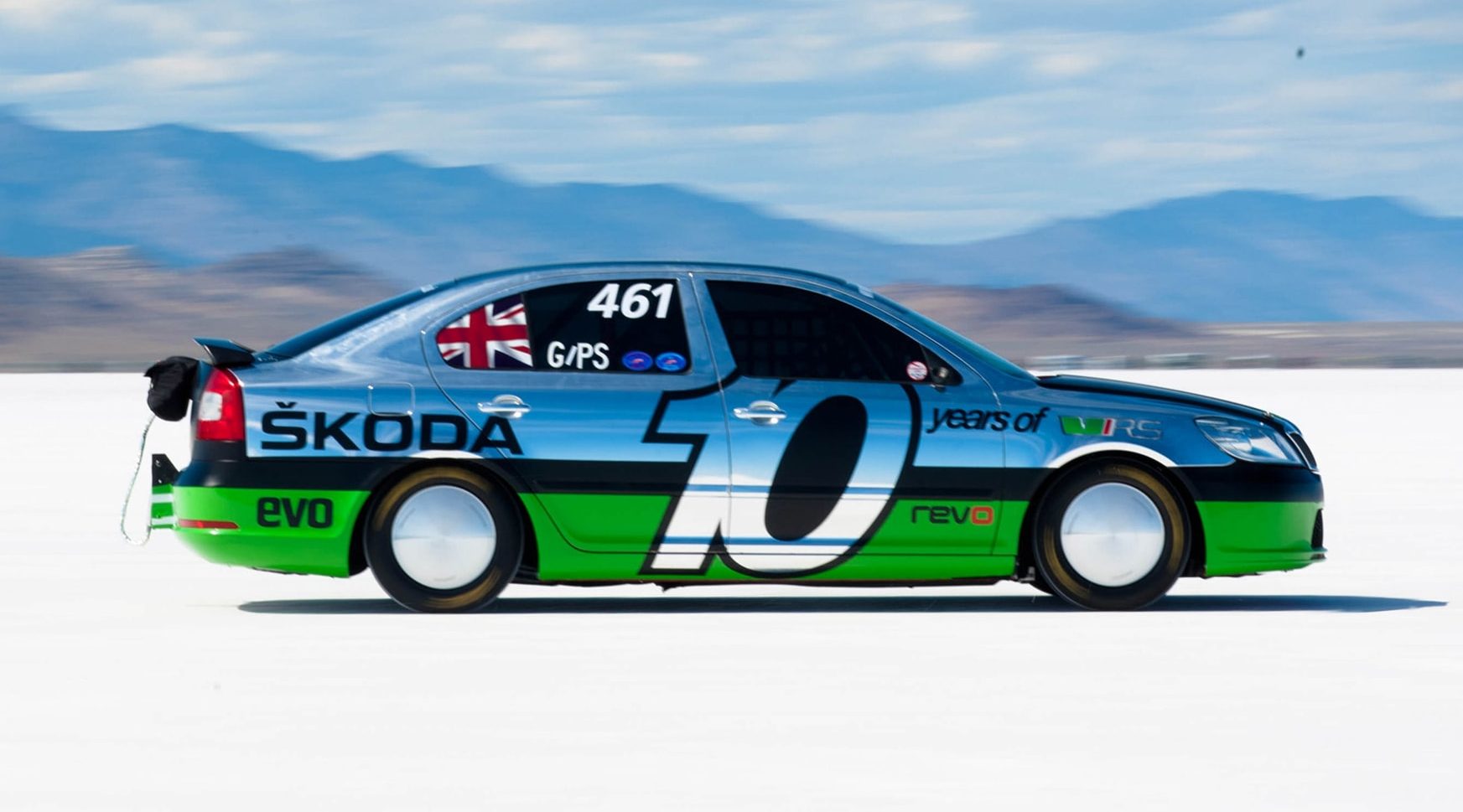 It’s been 10 years since Dickie Meaden and Skoda smashed the G/PS top speed record at the Bonneville Salt flats, we reminisce…
It’s been 10 years since Dickie Meaden and Skoda smashed the G/PS top speed record at the Bonneville Salt flats, we reminisce…